A trip to York
Despite the horrible events that I mentioned in the last post, my parents and I went ahead with the holiday we had planned, which was a trip to York.
I had never been to York or Yorkshire before, except for zooming through it on the train. And because our last family break to Winchester was so interesting (during which time we were also grieving for the loss of a family member; for God's sake, we need to stop making this a habit), I persuaded my parents that our next trip should be to York. I have always wanted to go; I had heard that York was a boon for fans of history and, not gonna lie, I also wanted to see where the events in "Jonathan Strange and Mr Norrell" were set XD
York lived up to my expectations fantastically. Everything there is so old and so interesting. As a result, this post is extremely photo-heavy. You have been warned!
For the practical parts of staying in York:
1. It's a fairly small city centre that's easily walkable. We stayed near Clifton, on the north-west side of the centre, so walked into town along Bootham every day.
2. Because York is old and interesting it is crammed with tourists, particularly large tourist groups and (on weekends) hen parties. Be prepared to fight with crowds. If it all gets too much, I recommend crossing to the west side of the river Ouse, where things are much quieter.
3. Because York is crammed with tourists, there are tonnes of attractions and almost none of them are free. Winchester had two great, free local museums, but not so York. I am unimpressed. We focussed on walking the streets and walking the walls, which are both free, and then we paid to go in the Minster. Having ignored all the other museums, I can't say what they're like, but the Minster is definitely a good one to choose if you plan to pay an entrance fee; there was tonnes to see, including a great museum in the crypt.
Right. This post is so long that I'm going to give you a table of contents:
1. "Jonathan Strange and Mr Norrell" sites:
1a. Ye Olde Starre Inne, Stonegate
1b. High Petergate
1c. Lady Peckett's Yard
1d. Coffee Yard
1e. Coney Street
1f. The Minster
2. The walls
3. Everything else
1a - "Jonathan Strange and Mr Norrell" sites: Ye Olde Starre Inne, Stonegate
Ye Olde Starre Inne, meeting place of the Learned Society of York Magicians. It claims to be the oldest pub in York, and for that we can forgive the sickeningly twee spelling in the name. How could I go to York without visiting this place?
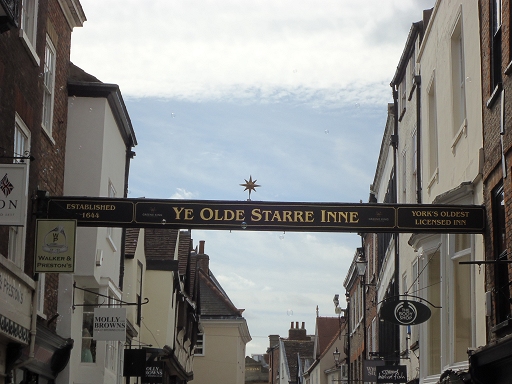
Here is the sign on Stonegate proclaiming the location of the pub. This sign is needed because the pub doesn't face the street; instead, to get there you have to go down a tiny little alleyway. (Warning, if you get stuck in the pub during a torrential downpour, as we did, the little alleyway will turn into a swimming pool. Then a gutter will burst just as your Dad walks under it, which will be both surprising and hilarious, to you, in equal measure.)
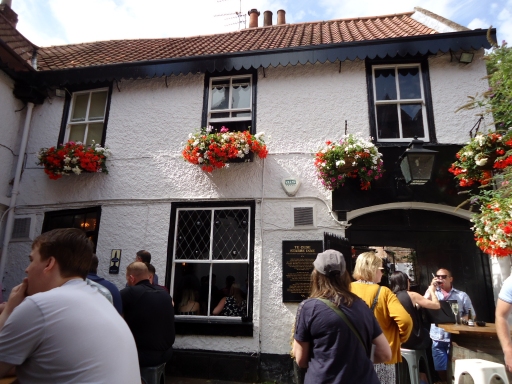
The little alleyway opens into this equally-small courtyard.
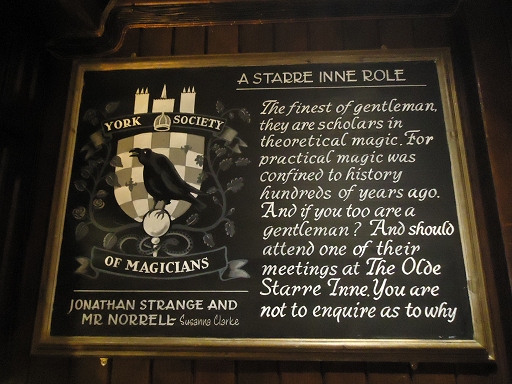
This board is the only mention of Strange and Norrell that I saw in the whole of York (York, you are missing a trick there; get your act together).
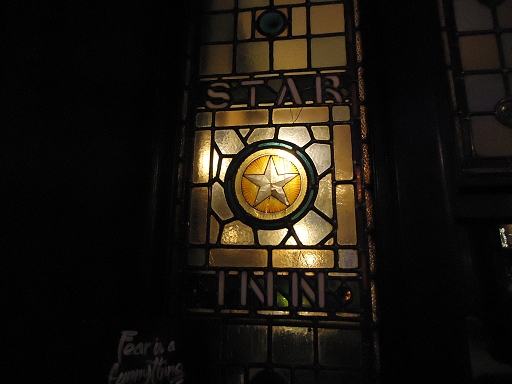
Unfortunately, the interior of the pub wasn't anywhere near as interesting as I hoped it would be. I could be wrong, but it looked to me like a very generic Victorian/20th Century restoration job. This glass window was the only part that caused me any excitement. Despite the pub claiming to be very old (and 1644 isn't that old anyway), I have been in plenty of pubs that looked far older and more interesting. The Starre Inne is full of tourists, uninteresting on the eye, and overpriced. My recommendation: take a photo of the sign then get out.
As an aside, a far more charming pub in my opinion was the Blue Bell on Fossgate. This pub doesn't claim to be old, but the decor is Edwardian dark panelling, fireplaces and patterned carpets. It's really small, really cosy, and contains everything my mind conjures up when it hears the words "English pub".
1b - "Jonathan Strange and Mr Norrell" sites: High Petergate
High Petergate, home of the Honeyfoots. Despite the huge numbers of tourists walking along it, I loved this street. We walked into town through Bootham Bar most days (see the walls section of the post for a picture of Bootham Bar), and it was so charming to see the street, and the Minster behind, emerge as you walked through the archway.
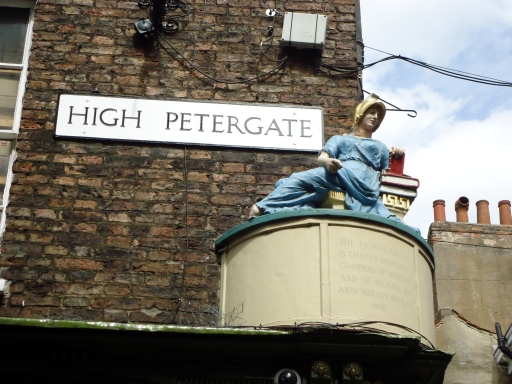
This ornate sign is at the crossroads between Petergate and Stonegate, which are (as I learned) the two main roads of the Roman fortress that originally stood on the site. How's that for ancient history?
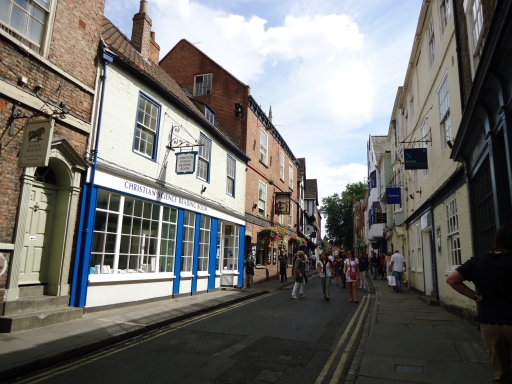
I spent a lot of time trying to work out which house the Honeyfoots lived in, but I couldn't quite make up my mind.
1c - "Jonathan Strange and Mr Norrell" sites: Lady Peckett's Yard
Lady Peckett's Yard, home of Mr Segundus (in some cold garret or other). Now this is where I really began to fall in love with York, and also where I began to think that Susanna Clarke only filled her novel with the streets she liked the best. How can you not be charmed by Lady Peckett's Yard? (Of course, to the 19th Century mind, it would presumably seem cramped and old-fashioned and not the sort of place that anyone with any money would choose to live.)
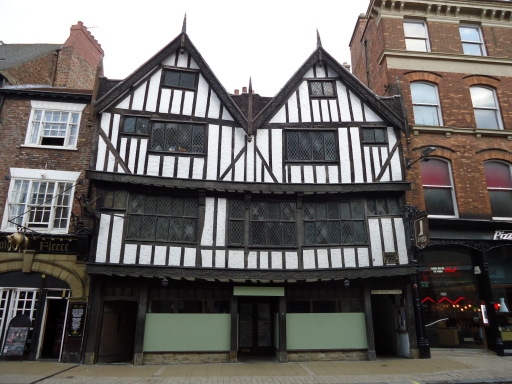
This gloriously-wonky building hides the entrance to Lady Peckett's Yard. The entrance is the little doorway on the right-hand side.
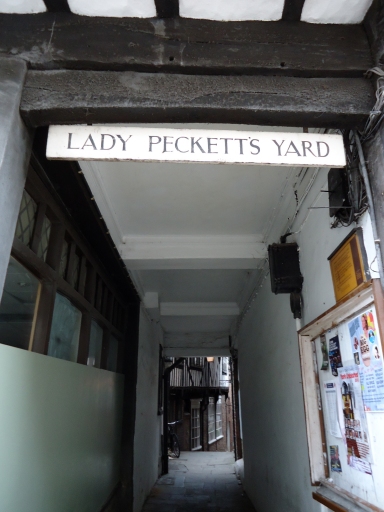
Here's a close-up of the doorway.
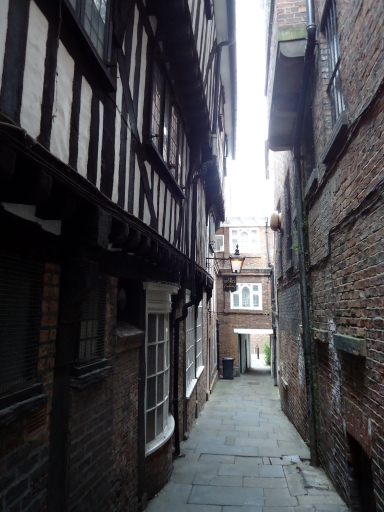
And here is the narrow, half-timbered wonder of Lady Peckett's Yard.
It was this that really introduced me to the snickelways of York, which are tiny alleyways that lead from one street to another. Some are long, some are very short, but almost all of them begin with what just looks like a doorway in an old house. (The word "snickelway" itself is sadly a modern invention. The alleyways, however, look very much like the sort of cramped lanes and yards that were a feature of many medieval towns and cities before most of them were cleared away in the 19th and 20th Centuries.)
1d - "Jonathan Strange and Mr Norrell" sites: Coffee Yard
I was now clutching at straws and scouring my copy of Strange and Norrell to find other streets in York that were mentioned. After all, the streets I had found so far were so charming that I wanted to see more.
Coffee Yard is the site of Thoroughgood's bookshop, which Norrell was known to frequent (or rather, Childermass on Norrell's behalf, one imagines).
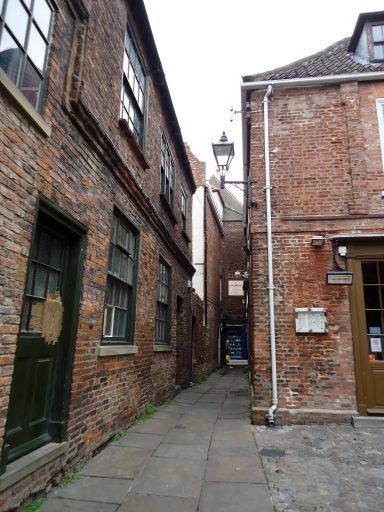
Coffee Yard is a really long snickelway. Halfway down is Barley Hall, a medieval house that's open as an attraction (for a fee, of course). Travelling down Coffee Yard is a fun piece of exploration. It also acts as a great shortcut if you want to cross town without running into too many crowds.
1e - "Jonathan Strange and Mr Norrell" sites: Coney Street
Coney Street is where Mr Robinson, Norrell's attorney, has his business (I told you I was clutching at straws!) Coney Street contains a lot of modern shops (with a few old half-timbered buildings, which all York streets seem to contain) so there isn't that much to look at. However, I was really taken by the church of St Martin le Grand.
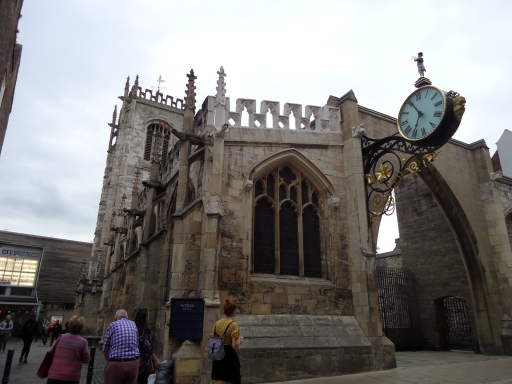
This church looks odd because it's a patched-up repair job after the church was badly bombed in the Second World War. The clock was apparently remade at that time, although the little figure standing on top of the clock is original. I can't get over the clock. It is so huge! I have never seen a clock that size so low on a building before. It gives the street a very odd look, as if you are dreaming and your mind is making up things that shouldn't be there in real life.
1f - "Jonathan Strange and Mr Norrell" sites: the Minster
I have saved the best Strange and Norrell site till last because I took so many photos of it. For anyone who has read the book, the Minster is the place where it all began, where Norrell made all the statues move and talk, proving that magic had returned to England.
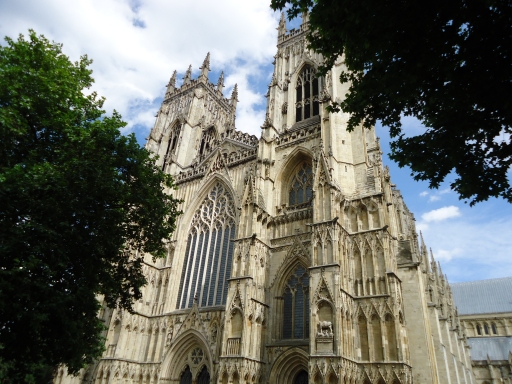
You can tell why Susanna Clarke choose the Minster for this scene. It is the most impressive building in all of York, and... well, let's just have it in her own words, shall we?
"And I hope that all my readers are acquainted with an old English Cathedral town or I fear the significance of Mr Norrell's chusing that particular place will be lost upon them. They must understand that in an old Cathedral town the great old church is not one building among many; it is the building - different from all others in scale, beauty and solemnity. Even in modern times when an old Cathedral town may have provided itself with all the elegant appurtenances of civic buildings, assembly and meeting rooms (and York was well-stocked with these) the Cathedral rises above them - a witness to the devotion of our forefathers. It is as if the town contains within itself something larger than itself. When going about one's business in the muddle of narrow streets one is sure to lose sight of the Cathedral, but then the town will open out and suddenly it is there, many times taller and many times larger than any other building, and one realizes that one has reached the heart of the town and that all streets and lanes have in some way led here, to a place of mysteries much deeper than any Mr Norrell knew of."
This passage holds true, even in the 21st Century. There aren't many tall buildings in York, so you can still see the Minster from miles around (you'll notice this in some of my later photos).
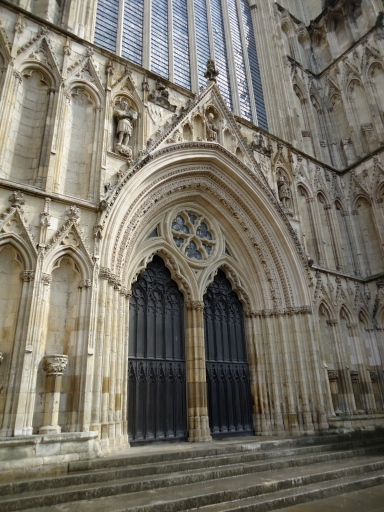
The west door, which I had to take a photo of because I recognised it from the TV show. "I will not sign." But no matter how much I loitered on the steps, I never managed to look as brooding as Childermass.
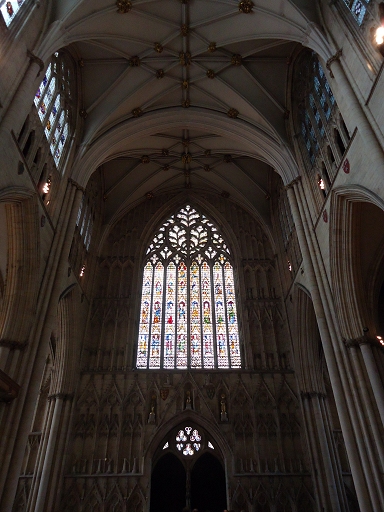
The interior of the Minster was full of people, but the building is so tall it just swallows them up. And there's so much to look at. We were there for about two and a half hours, and then had to come back the next day for another two and a half.
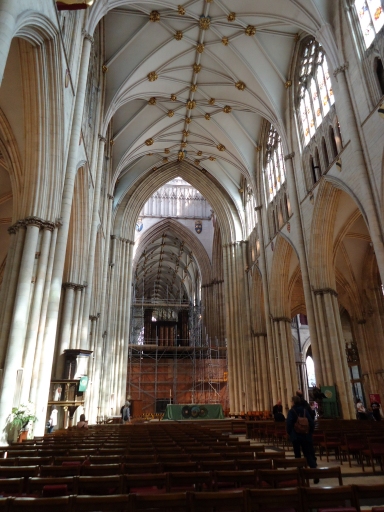
There's restoration work happening to the quire screen, hence the scaffolding.
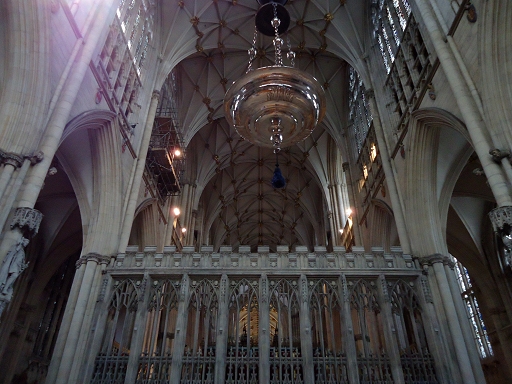
When we reached the east end of the Minster, just behind the high altar, the heavy rain outside turned into thunder and lightening. Meanwhile, the organist decided to start their organ practice. There is something very special about sitting in the gloom of that place, hearing the roll of the thunder accompanied by organ music. Honestly, if all the bells had started ringing at once I wouldn't have been surprised; it felt right.
Which is an interesting thought to me. Doubtless, the grandeur of the architecture has something to do with the magical feeling in the place. But I think it also shows just how deeply Christianity is ingrained into our culture that I, who was raised an atheist, am still affected by the atmosphere in there.
Also interesting to me was that down in the crypt there were a couple of Roman ruins exposed (showing the ruins of the Roman fortress that was on the same site). The Roman ruins were lower than the ground level of the crypt, and when you looked down the holes with them in, you would sometimes see water. In every one of these holes were modern coins that had been thrown in. How is that for continuity of belief? It's a far older tradition than Christianity (it sounds like it's closer to offerings the Romans made, if you ask me), but if people see a bit of water like that, they have to throw coins in for good luck. It just goes to show how much religious ritual is absorbed rather than specifically learned. Ask anyone nowadays why they threw a coin in a well, and they would only be able to give you a vague answer. But in the depths of our culture, coins and water are linked with the supernatural, just as much as churches, extremes of weather, and the ringing of bells.
tl;dr there was thunder while we were in the Minster and it was cool!
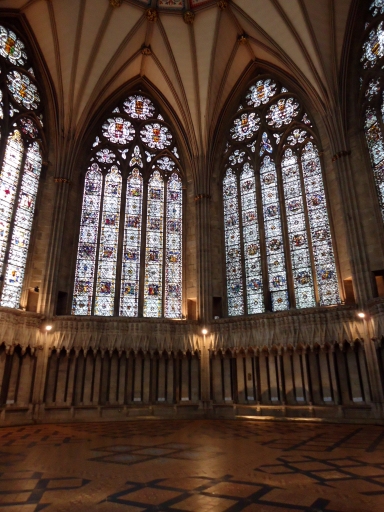
Perhaps one of my favourite places in the Minster was the chapter house. I mean, just look at it. This is where the most important members of the clergy did their work, so of course it would be one of the prettiest places.
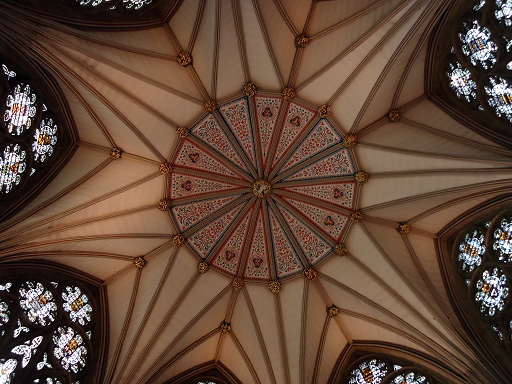
Look up in the chapter house and this is the ceiling.
Now, this wouldn't be a Strange and Norrell-inspired trip to the Minster without imagining what it would have been like if all the statues in the building began to talk. So I decided to take as many photos of statues as I could. (Of course I couldn't get anywhere near close to photographing them all. There are so many of them! They have colonised the whole building!)
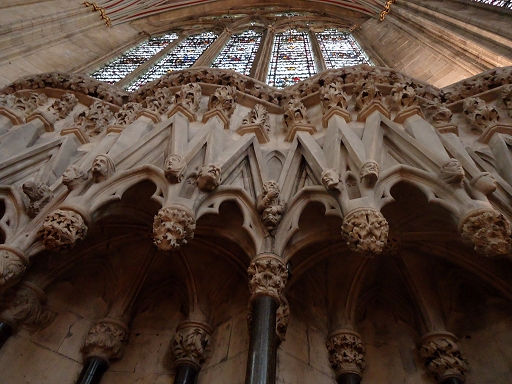
Let's start with the chapter house. At first you don't notice the little statues, but when you begin to look closely you see them.
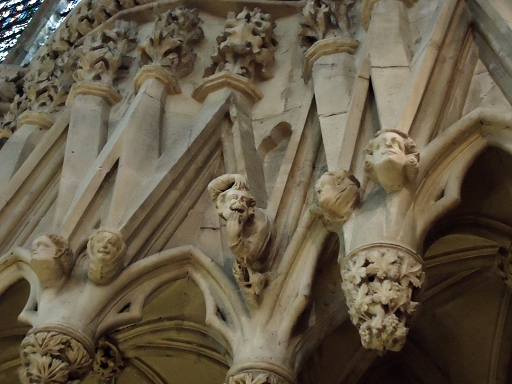
Every head in the chapter house is different and they all have their own personalities (some of them, not very religious at all). Look at this guy having fun!
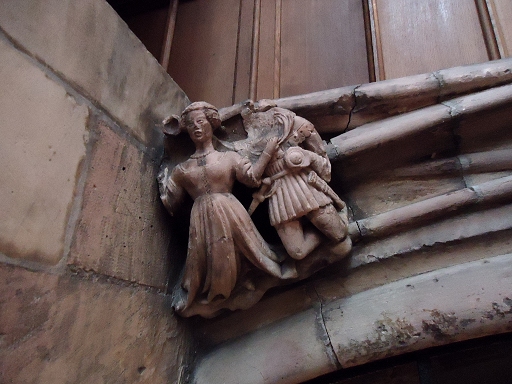
Some of the statues in the Minster look new (there's an ongoing restoration project) but some look forlorn and neglected. There are actually many that appear to be headless on purpose, due to zealous destruction in the reformation. And when you look around you, you realise that there are many more plinths that once held statues and are now empty. You have to wonder what the place would have looked like in medieval times, with all of the statues in their places and most painted. I can't even imagine.
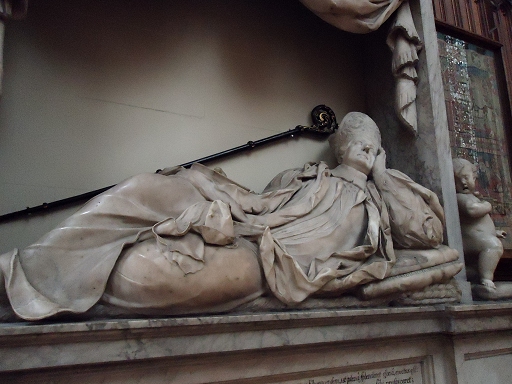
In the east end of the church are lots of memorial statues, many to archbishops, like this one. I like his style. So laid-back!
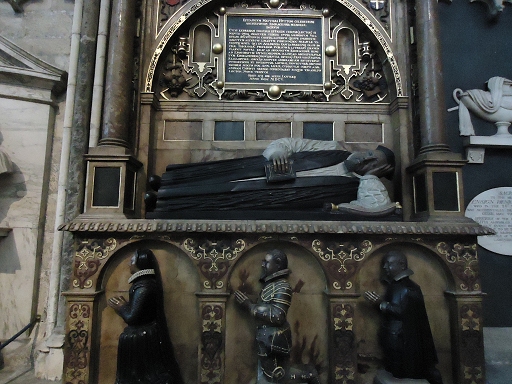
This is a much earlier version of the same pose. Not so laid-back.
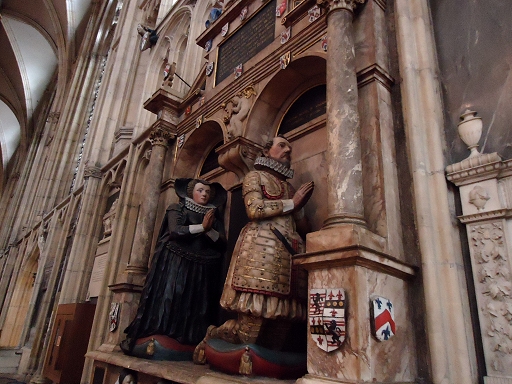
It was actually really interesting to compare how statue styles changed over the centuries. Here's another old-style one, with the figures devoutly kneeling.
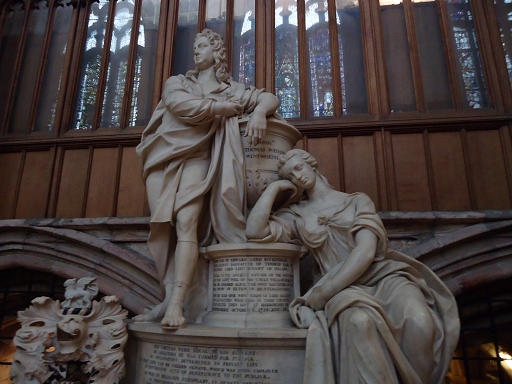
And a similar monument in a much more informal, later style.
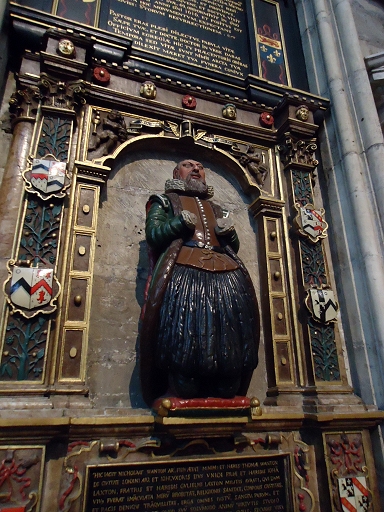
This guy was presumably praying, before his hands were cut off.
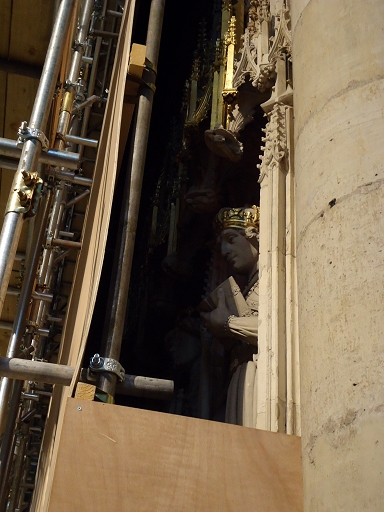
Here we have the famous Kings' screen, all boarded up. Apparently it had only been boarded up for about two days, but the restoration work will last for months or years. I'm so miffed we got our timing wrong!
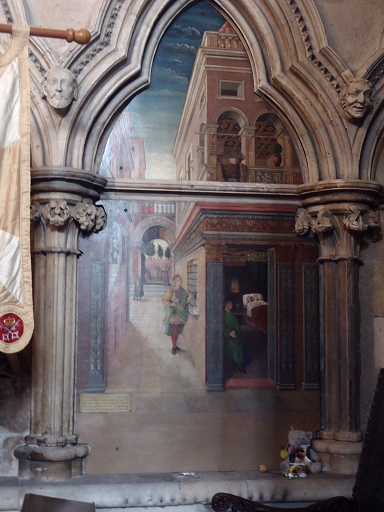
When thinking about statues talking, you have to wonder if paintings count too, because there were a number of those. This lovely renaissance one (look at that perspective!) was hidden away in a side chapel with no-one paying any attention. Note, also, that it's still surrounded by statues.
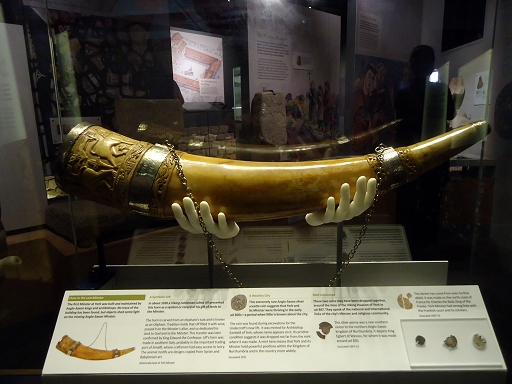
Would carvings count? Like these on the horn of Ulf down in the crypt? Honestly, this is one of the best things I saw. I can't get over it. Did you know it's actually a deed for landholding? A Viking deed. Made out of an elephant's tusk. Mind=blown.
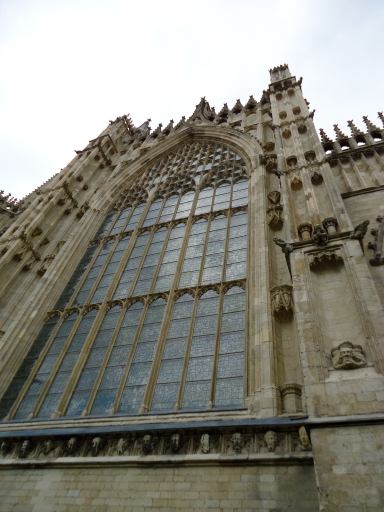
And finally, there are all the statues on the outside of the Minster too. Note the row of heads underneath the window. Also note the many niches that no longer hold statues any more.
What a place. When writing the Minster scene, Susanna Clarke definitely knew what she was about.
2. The walls
Right, let's move away from Strange and Norrell and back into real life, because even without the book connection, York is such a fascinating place to walk around. On one day we decided to walk the walls (it's free!)
The city walls in York are in a ridiculously good state of preservation. I mean, I know that most of the path you're walking on is fairly recent, but for the walls to be tall enough for a path to be reconstructed is astounding. Plus, so many of the old gates still survive. In some towns you will get one or two gates; in York there are more than I can count. Well done to the people of York for not destroying them! (I mean, you have to wonder if their survival relates a lack of 19th Century industrialisation, so there just wasn't the commercial pressure to remove the walls as there was in other places. In which case, well done, stagnation!)
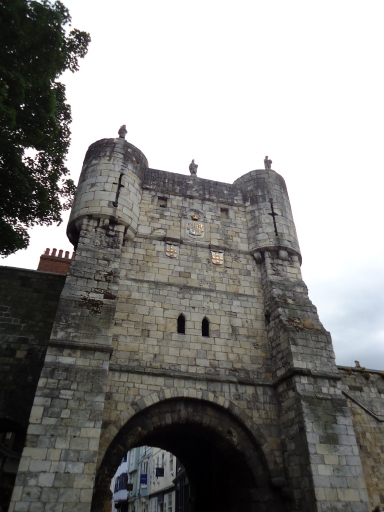
We started, as we did almost every day, with Bootham Bar. Remember, this is the gate at the end of High Petergate. (While we're here, a word on naming: "gate" in York street names doesn't mean gate, but is instead a Viking word for street, so most streets have "gate" in their name without having an actual gate on the street. Are you with me? Meanwhile, to avoid confusion with the street names (one assumes), the actual gates in the walls aren't called gates but "bars". Yes I still got confused with it, even after a whole week.)
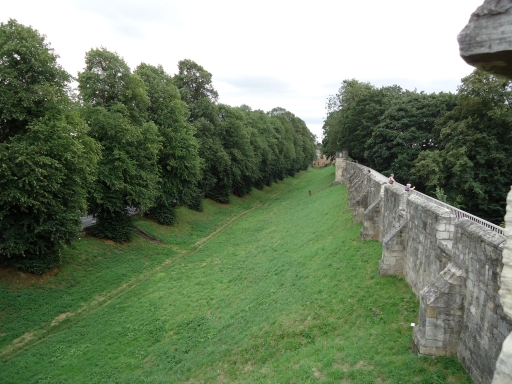
On some parts of the walls you can see the moat on the other side. Like many city walls, they were first built by the Romans, and then added to and embellished in later centuries. The last time the York walls were used for defence was during the civil war.
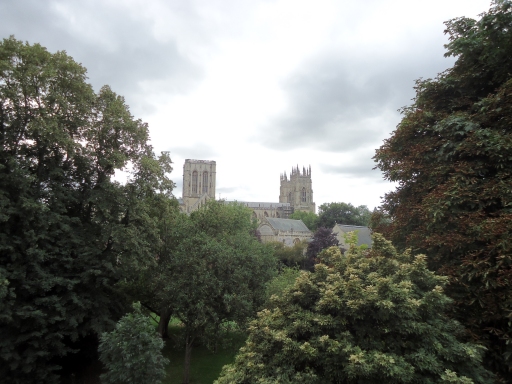
So many times when walking the walls you would turn around and suddenly see the Minster looming above everything.
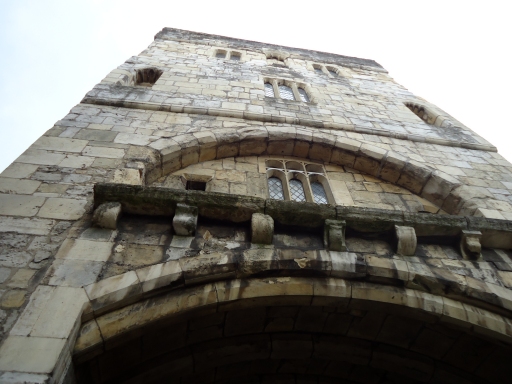
Monk Bar.
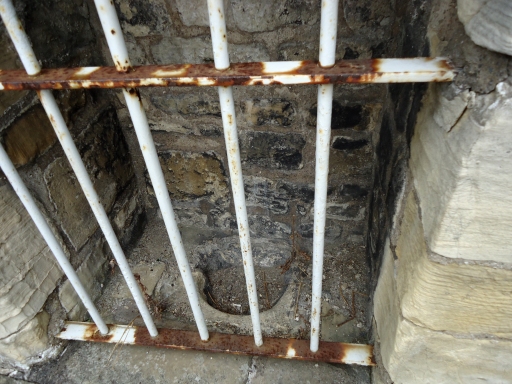
There's still an old toilet in the walls. The waste would drop down into the moat (or on your enemies if they were trying to invade, I suppose). I can't get enough of old toilets; it really helps to bring history to life to see everyday ordinary stuff.
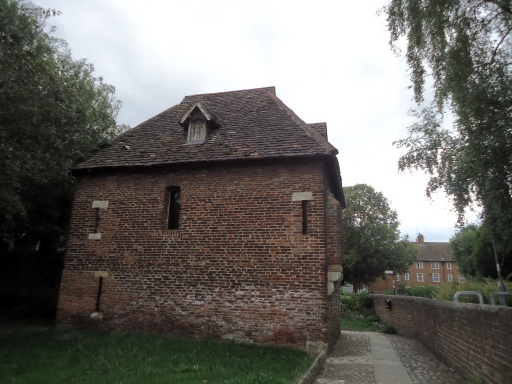
The Red Tower. This wasn't one of the main bars, but was instead one of a number of posterns (I just learnt the word!) It's the only tower in the walls to be made of brick instead of stone (which apparently made the stonemasons so angry they went on a murdering spree).
Next to the Red Tower used to be a huge, man-made lake for defence. On the right-hand side of the tower you can still see the toilet (another one!) that used to empty into the lake. There's no lake at all there now, just a long stretch of road with no wall and the name Foss Islands Road.
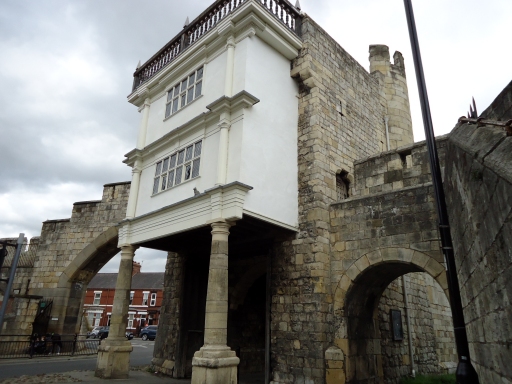
Walmgate Bar. This used to be a very poor area of town (there's still council housing there now) so there was less commercial pressure to relieve the traffic, which is why this is the only bar to retain its barbican (an extra gate-y bit at the front to make it even harder for attackers to get in).
In Walmgate Bar it's really easy to see how it was altered to make it more comfortable to live in. Surprisingly, most of the bars were used as residential accommodation, even from very early days. It helped pay for the upkeep, I suppose. But can you imagine living in there? I love the thought of living in a little gatehouse!
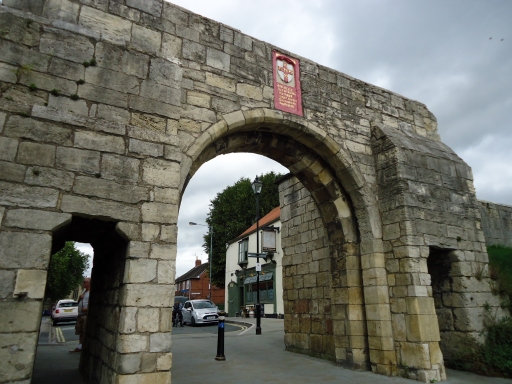
Fishergate Bar. This one is so small against the others! I forget if it has been dismantled or if it was always that small. (Did it burn down at one point?) I can remember reading that lunatics were supposedly locked up in the towers in Fishergate Bar. Oh God the poor people!
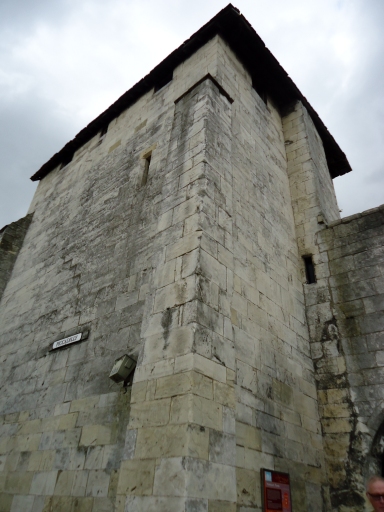
Fishergate Postern. This is another one with an obvious toilet, but the toilet didn't make it into the photo. This tower stands on a road now, but the River Foss used to come up to its edge, I think.
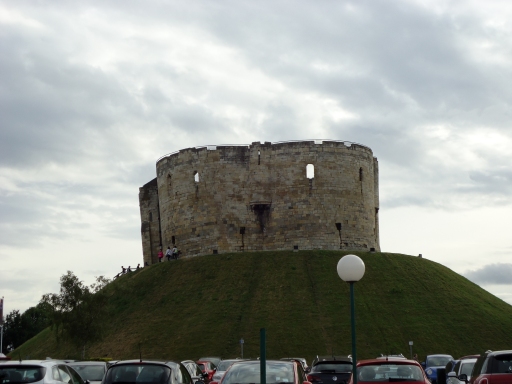
On the other side of the River Foss was the Norman castle! Other than a few bits of wall, the only part of the castle that stands is the keep, known as Clifford's Tower. I believe the technical term for a castle that looks like this is "on the piss".
When we walked past the castle, there were two young kids on the grass having a big fight with plastic swords and shields. They were having a great time, fighting by a real castle, let me tell you.
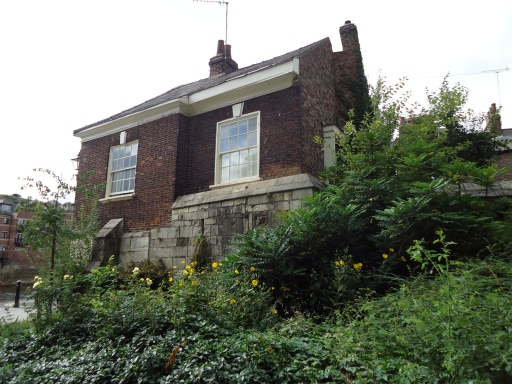
Near Clifford's Tower the wall continues down to the next river, the Ouse. This is Davy Tower, the tower right beside the river, although at some point the tower got converted into a house. As with other towers on the river, a chain could be run from Davy Tower to a Tower on the opposite bank to stop people from entering York via the river (whether the chain was to stop attackers or just to stop traders from sneaking in without paying tolls, I don't know).
On the other bank of the river was once another Norman castle, built by William the Conqueror to help with the harrying of the north. I don't like that part of the story; it's too sad. The population of York was devastated, just like the rest of the north of England. (It makes it quite easy to imagine a fictional world where the locals would support a new invading king, because surely he's got to be better than the Normans, even if his army is made of fairies.)
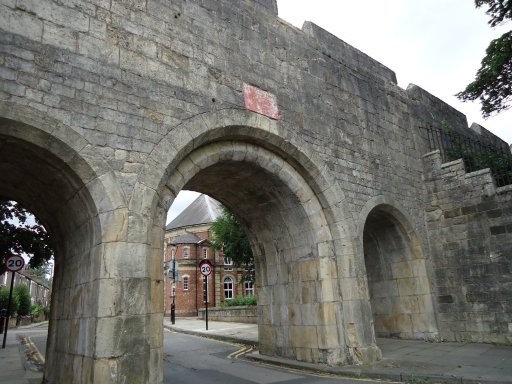
Victoria Bar, built (unsurprisingly) during Victorian times. More interestingly, when they built the Bar they discovered the remains of an old, blocked-up gate that everyone had forgotten about. It is thought that the blocked up gate was the medieval Lounelith (meaning "secluded gate").
(As an aside, between the now-lost second castle and Victoria Bar, there is a tower that, I kid you not, is called Bitchdaughter Tower. Bitchdaughter. Tower.)
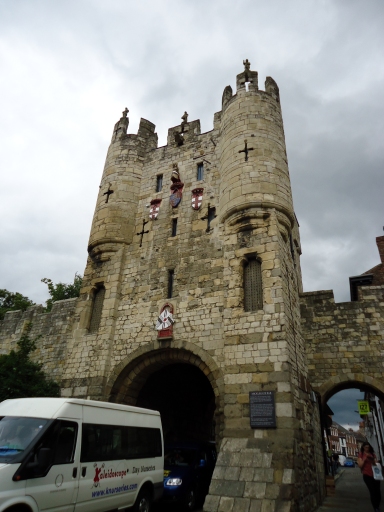
Micklegate Bar. This is apparently the fanciest of the bars because it faces south, so is the bar that the King would use to enter the city.
Just take a moment to appreciate how, like a number of the other bars, there is still a working road running through Micklegate Bar. Traffic has passed through there for centuries and centuries!
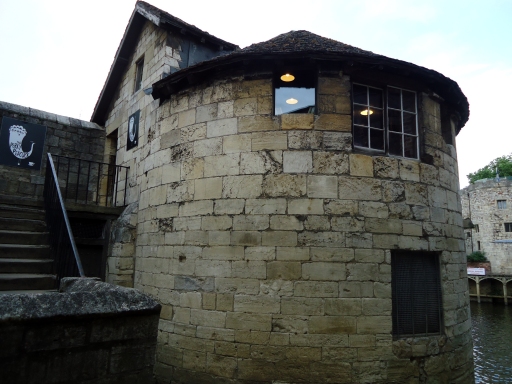
Back round to the River Ouse again and we get to Barker Tower. I loved this tower; it's so cute with its tiled roof.
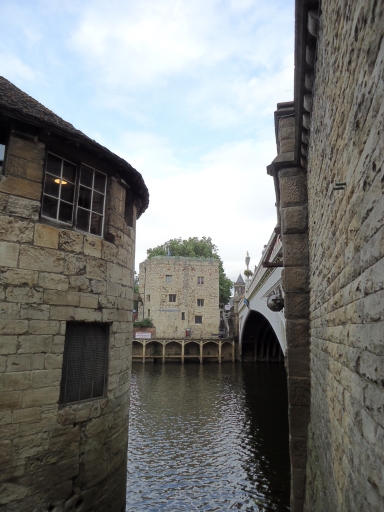
Over the river from Barker Tower is Lendal Tower. As I've mentioned before, a chain could be run between both towers to stop people from entering the City via the river. The bridge connecting the two is Victorian; before it was built, I think a ferry ran between the two banks at this point.
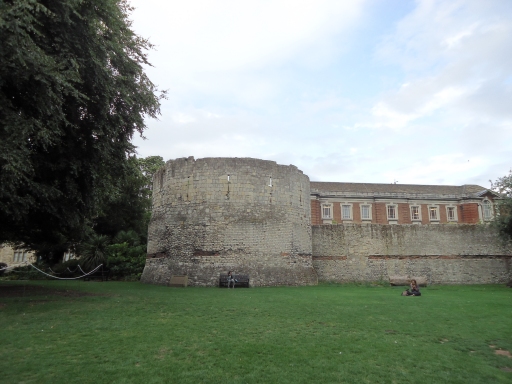
Across the river you can no longer walk on top of the walls, so have to view them from the side. This is the Multangular Tower. The bottom part of the wall and tower, with the red stripe, is proper Roman (the tower makes up one of the four corners of the old Roman fortress).
After the Multangular Tower, the walls continue for a little way, but then disappear because a 19th Century road was cut through them. They start again with Bootham Bar, which is the gate where we began the wall walk. We didn't hang around for long at the end of the walk though, because it had started to rain.
3. Everything else
York was such a pretty place to walk around, so I took as many photos as I could. The place has medieval half-timbered buildings around every corner, with much of the rest of the architecture being Georgian. Compared to other cities, only a tiny fraction of the buildings in the centre of York are Victorian or later.
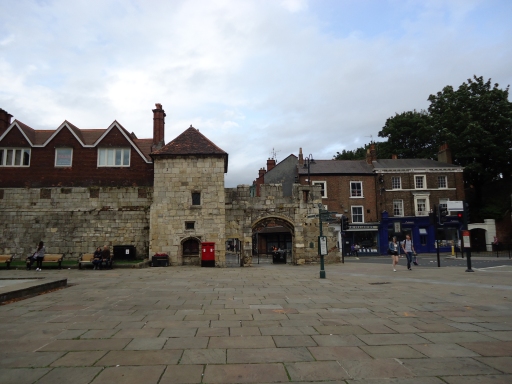
Continuing with the wall theme, very close to Bootham Bar you get this section of wall. These aren't actually the city walls, but are instead the walls of St Mary's Abbey, which sat just outside of the city. This Abbey was huge and very wealthy, until Henry VIII got to it.
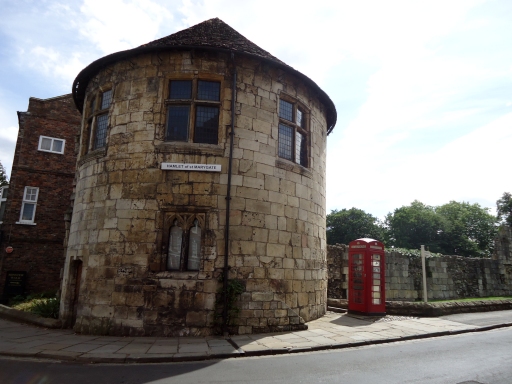
On the other corner of the Abbey walls is this funny round tower. I have come to the conclusion that I love round towers with tiled roofs like that; it's like it's wearing a little hat!
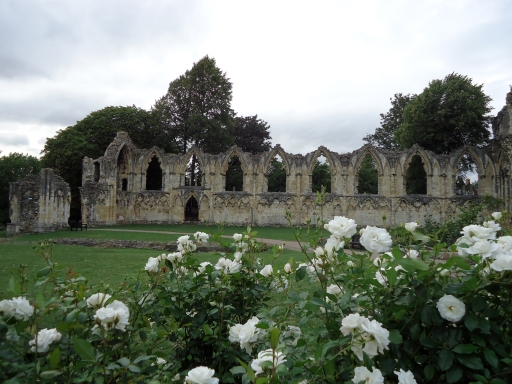
Here are the ruins of the Abbey itself. The Abbey grounds are really quite big; we spent a lot of time walking through them.
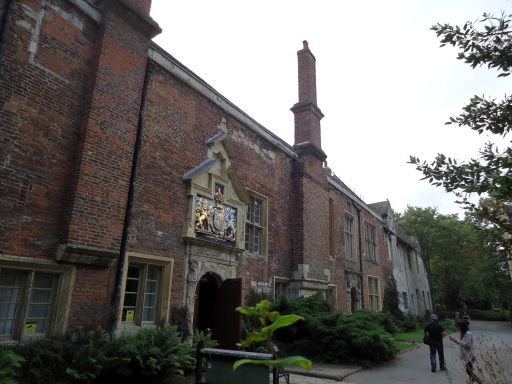
Near the Abbey is the King's Manor, which is a building that looks like it's been in occupation for a long time. I love staring at buildings like these and trying to work out where old windows and doors used to be.
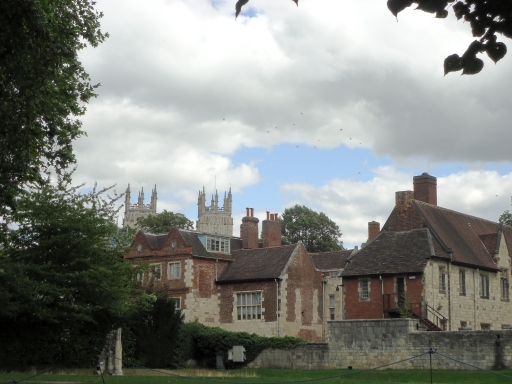
A view of the Minster from the Abbey grounds. I think the building in front is still the King's Manor.
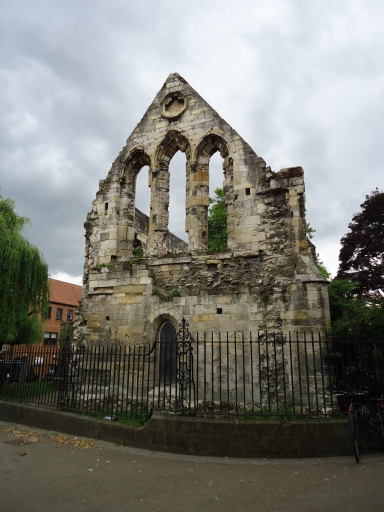
Near the Abbey, but this time inside the old city walls, is another old religious institution: St Leonard's Hospital. Again, the hospital didn't make it past the dissolution of the monasteries.
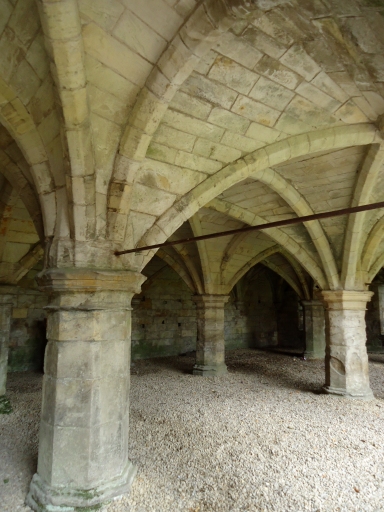
Part of the crypt of the hospital is still standing.
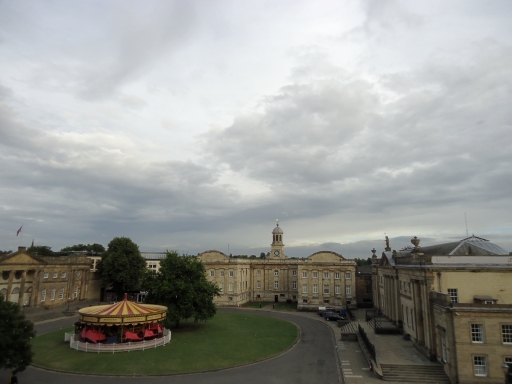
This image was taken from on top of the mound that Clifford's Tower stands on. Being the old castle, this area of York has been used for law and order for centuries. The grassy area is called the Eye of York. The building on the right is York Crown Court. The other two buildings used to be prisons.
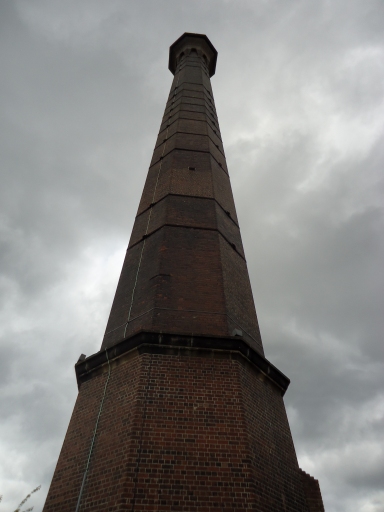
Not far from the wall walk, we found this old Victorian chimney. I forget what it was for; a waste disposal site?
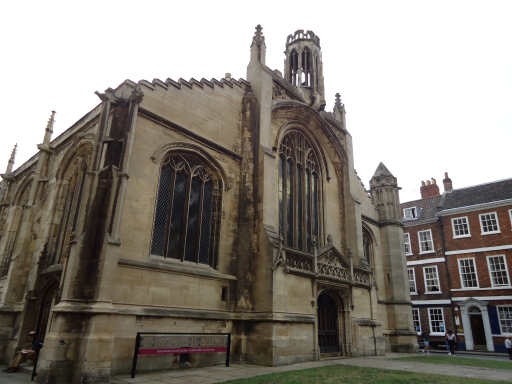
Next door to the Minster is the church of St Michael le Belfrey. I haven't been able to work out if the church is related to the Minster in any way, or what the church's strange name means. If anyone could let me know, I would be grateful!
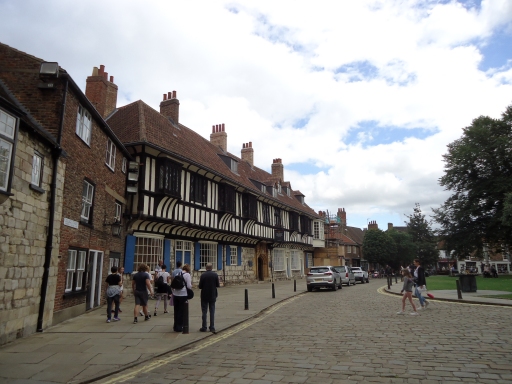
Behind the Minster is this lovely old building, which is now a conference centre. It's called St William's College, and like so much in York, was used for religious purposes. I think members of the clergy lived there?
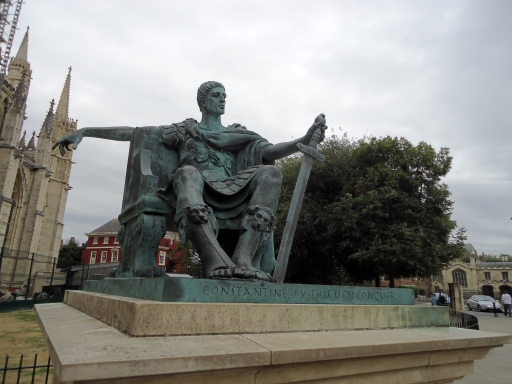
Outside the Minster we also have this statue of Constantine the Great, who was proclaimed emperor while in York. I love this statue. Look at him. He doesn't give a shit. He doesn't care one iota about anything.
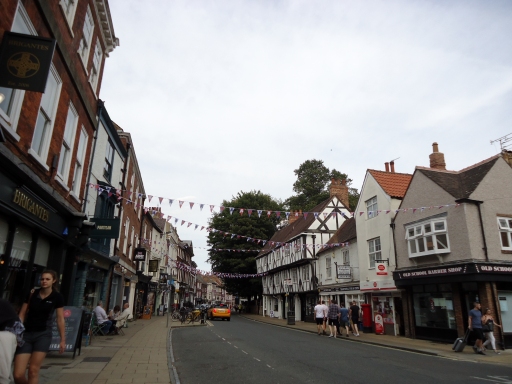
Micklegate. This is so clearly an old street. Look at that building with the projecting storeys on the right. However, this photo was taken at about 5:30pm on a Saturday evening. Already the street was getting a bit lary. Which was odd. 95% of the time York is quaint, pleasant and touristy, but on a Saturday evening the city lets its hair down and things get real.
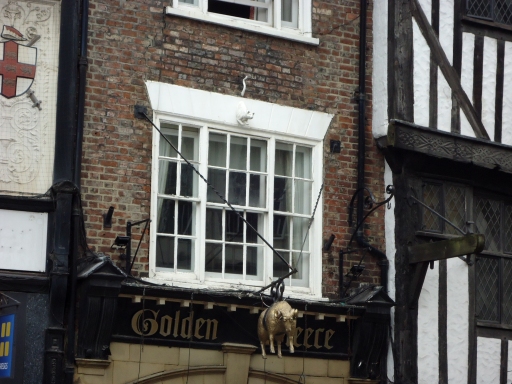
We never went into the Golden Fleece. (By the way, the building next door to it on the right is the building that contains the entrance to Lady Peckett's Yard.) Apparently the Golden Fleece is meant to be really haunted? I don't know; I didn't pay much attention to that part, but look at the cool ghost cat statue above the window!
There are cat statues all over York. You can even follow a walking trail that will take in all of them. Of course we had to do the cat walking trail. It's a good little walk, and the cats are on some interesting buildings. One of my favourite parts was walking down a street called Bartle Garth, because the street name cracked me up; I insisted on calling it Slartibartfast.
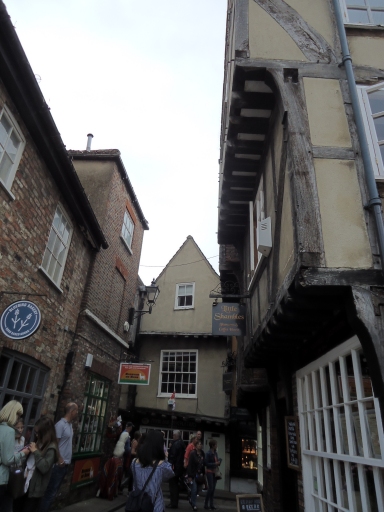
The Shambles, as seen from the Shambles Market. I loved the Shambles. The buildings are so old, and so wonky, and they still contain period features! Unfortunately, the Shambles was always so busy that I couldn't really take photos of it. The busiest part was by a Harry Potter shop (is there some kind of Harry Potter connection to York that I don't know about?) and I have never been more glad that I am not a Harry Potter fan; the queue for that shop looked excruciating.
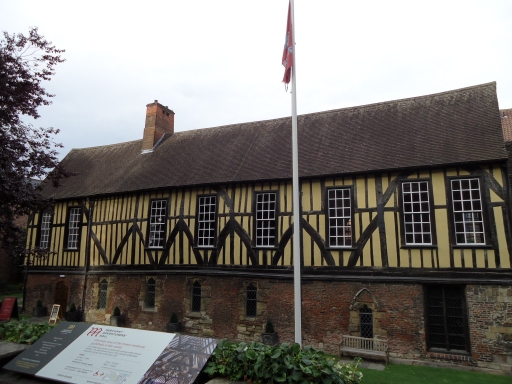
Merchant Adventurers' Hall. There were actually quite a few guild halls in York. That, coupled with the large number of churches, just goes to show how big and how busy York was in the middle ages. Of the guild halls, Merchant Adventurers' Hall was the best-looking from the outside, in my opinion.
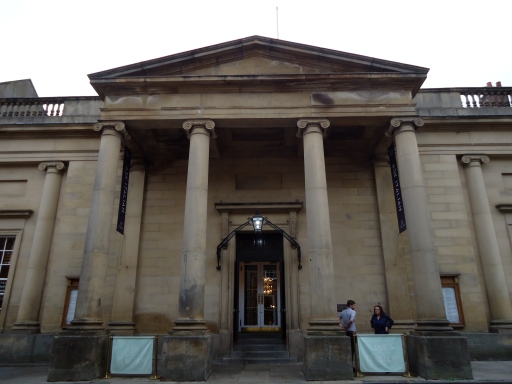
Now for something a lot more Georgian: the Assembly Rooms. This building is currently an ASK Italian restaurant. I forced my parents to eat there so we could see inside.
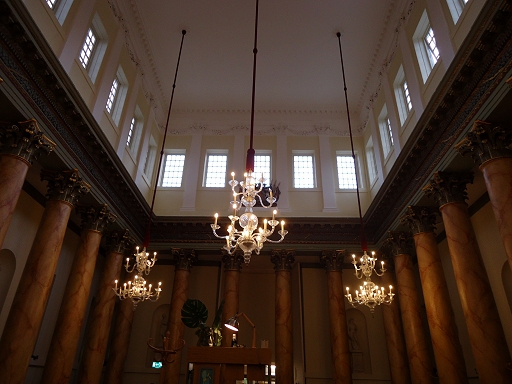
The interior of the Assembly Rooms does not disappoint.
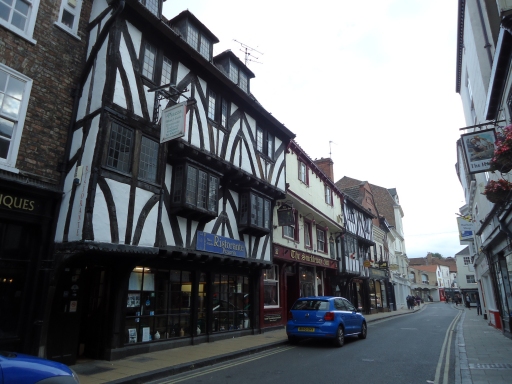
Goodramgate. Look at those jetties! Like most York streets, Goodramgate has tonnes of old buildings just hanging out and doing everyday stuff, as if their survival over the centuries wasn't exceptional.
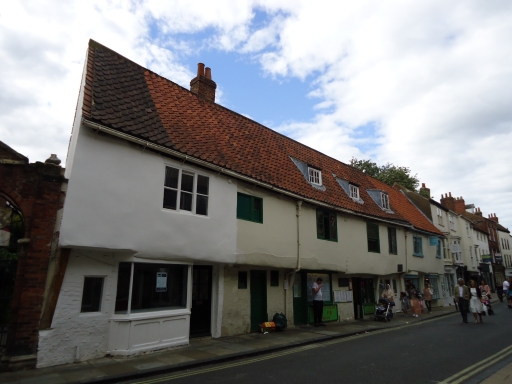
Also Goodramgate. This row of houses is called Lady Row. They don't look as swish as the last photo, but apparently they're the oldest row of houses in York, built in 1316. 13 - bloody - 16! Behind them is Holy Trinity Church, which you can't see, because the houses were built in the churchyard, specifically so the rents could go to the upkeep of the church.
1316!
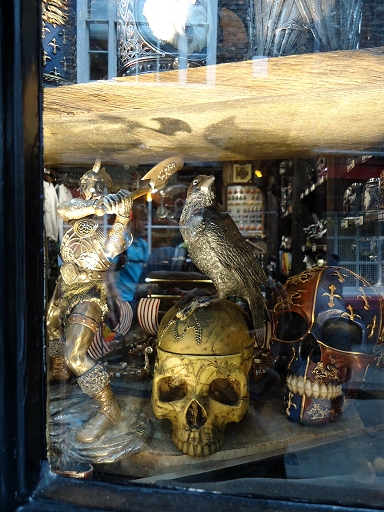
Finally, York contained lots of ridiculous, touristy shops, like this one that specialised in Viking-themed goods. I had to stop and take this photo, because how could I go to York without taking a photo of a raven? (Shut up, yes it might be a crow, but for my purposes it's a raven.)
In conclusion: I loved York. I loved it! So much history everywhere! We hardly scratched the surface. Since coming back to London, I've been watching nonstop documentaries about York's history and moping about the fact that my holiday is over.
When can I go back?